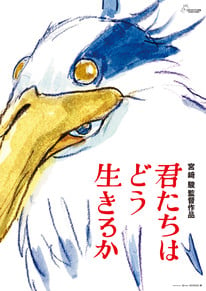Review
by Richard Eisenbeis,The Boy and the Heron
| Synopsis: |  |
||
After Mahito's mother is killed during the firebombings of Tokyo, he and his father move out of the city to live with his maternal aunt—who is already pregnant with his new half-sibling. Struggling to accept both his mother's death and new familial situation, Mahito is harassed by a talking blue heron who promises that, if they go to a nearby abandoned mansion, he can meet his mother once more. |
|||
| Review: | |||
It's been 10 years since Hayao Miyazaki, arguably the most famous anime director of all time, made a feature film. In 2013, Miyazaki himself was content to retire and let The Wind Rises be the last film that he would ever make. This raises the natural question, why does How do You Live? exist? What drove the now 82-year-old man back into the director's chair? According to the film's producer, Toshio Suzuki, in an appearance on the Japanese TV program Nichiyobi Bijitsukan back in 2017, the film is for Miyazaki's grandson—a way of saying "Grandpa is moving onto the next world soon, but he is leaving this film behind." And truly, that's the core of this film—experiencing the death of a loved one and coming to terms with it. Not simply, “How do you live?” but rather, “How do you live on when someone you love is gone forever?” Our hero, Mahito, is a good kid—obedient and polite. But while he's respectful to his aunt and the numerous elderly people she takes care of, he is self-destructing on the inside. What he wants is the old life he had in Tokyo with his father and mother—not this one in a new place where he knows no one and his father is already making a new family with his aunt. At first, he lashes out at himself—getting in a fight after school and then giving himself a gushing head wound so he doesn't have to go back. Then, he moves on to lash out at something that can't fight back—the blue heron living in a neighboring pond. The message here is clear. These are obvious outward signs of a troubled kid—both then and now. Pain and grief are universal things—and only by recognizing the signs can we help those in need. The film, for all its fantastical trappings, is the story of Mahito coming to accept what he still has—and fighting to make sure nothing more is taken away from him. It's a thematically powerful narrative—and one that uses visual storytelling far more than dialogue to get its message across. However, as strong as the themes are, the fact remains that the film is often exceedingly predictable. It's obvious from the start what the thematic shape of the film will be—how Mahito's arc will unfold. The major plot twists are likewise obvious—especially as to the characters' true identities throughout Mahito's adventure. What's not predictable is everything else. The world Mahito travels through is unlike any seen before—even in Miyazaki's other similar films. From oceans with monstrous fish to cities full of man-eating parrots—you're never sure where the film is going next or who Mahito will meet there. All that's certain is that Mahito has a goal and he's not willing to return home until it has been accomplished. Of course, half of what makes the fantasy elements so powerful is the animation. It's truly astounding. Every frame of this film feels like a separate work of art—one that only becomes grander when put together as part of the greater whole. It's a film you could watch a hundred times and still discover new things in the background of any given scene. It cannot be understated how the little visual details take the film from real to surreal—like a heron flashing a toothy grin or wooden dolls vibrating as if in sympathetic laughter. It's an animation tour de force unlike anything seen in the past decade. And as for the music, it fits the visuals perfectly. Joe Hisaishi once again brings his A-game to another Studio Ghibli film, creating a score filled with both whimsy and tension. All in all, How do You Live? succeeds at what it's trying to be—a roadmap for dealing with the loss of a loved one couched within a fantastical tale. It's designed to tell those suffering from such feelings that they are not alone while also showing them how to find importance in the greatly-changed world they find themselves in. While it can be predictable at times, it is every bit the visual masterpiece expected of Miyazaki's films and will no doubt become a classic in the decades to come. In the end, while it may not be the absolute pinnacle of Miyazaki's films, it's still a great one—and certainly not a bad one for Miyazaki to go out on. |
| Grade: | |||
|
Overall : A
Story : B+
Animation : A+
Art : A+
Music : B+
+ A story about the loss of a loved one and coming to terms with it told with Miyazaki's usual fantastical fair. |
|||
|
discuss this in the forum (19 posts) |
this article has been modified since it was originally posted; see change history |
|||
| Production Info: | ||
|
Full encyclopedia details about |
||